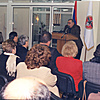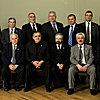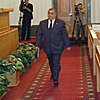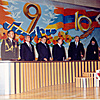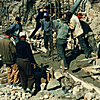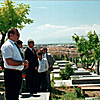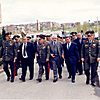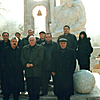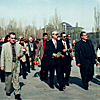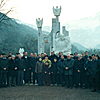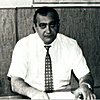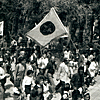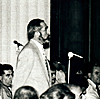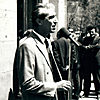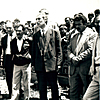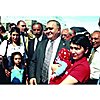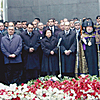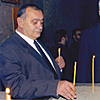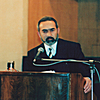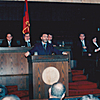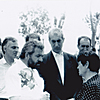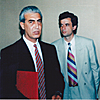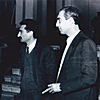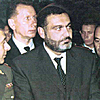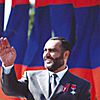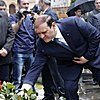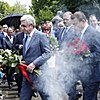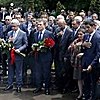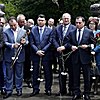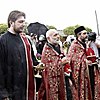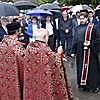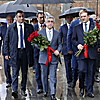History of the Party
25 years of dynamic performance in the political system of Independent Armenia
From RPA history
.jpg) The Republican Party of Armenia (RPA, established in 1990), is one of the unique organizations operating on the Armenian political scene, with decades-old ideological and political roots. The RPA ideological basis is Garegin Nzhdeh’s teaching. Some members of clandestine National United Party of 1967-1987 continue their unique work within the party and its Board. In this regard the RPA is the ideological and political successor of Nzhdeh Tseghakron Professios and National United Party, which in the days fateful for Armenian people became the torch bearers of the ideas of independence both in Diaspora and Armenia.
The Republican Party of Armenia (RPA, established in 1990), is one of the unique organizations operating on the Armenian political scene, with decades-old ideological and political roots. The RPA ideological basis is Garegin Nzhdeh’s teaching. Some members of clandestine National United Party of 1967-1987 continue their unique work within the party and its Board. In this regard the RPA is the ideological and political successor of Nzhdeh Tseghakron Professios and National United Party, which in the days fateful for Armenian people became the torch bearers of the ideas of independence both in Diaspora and Armenia.
The birth of the RPA is also organically linked to the 1988 National Awakening, fight for independence and Artsakh national liberation struggle. The military-political unit Army of Independence, formed at the outset of the struggle, became the organizational basis of the RPA establishment. On 2 April 1990 the founding council composed of the detachment commanders of the Army of Independence proclaimed the establishment of the Republican Party of Armenia in Yerevan and became the first officially registered socio-political organization in the Republic of Armenia (registered on 14 May 1991).
During the war first the Army of Independence, later the detachments composed of RPA members had an active participation in the struggle for the defense of the borders of Armenia and liberation of Artsakh.
On 27 May 1990 these detachments were among the first to resist the Soviet troops in Nubarashen. They were also actively involved in the nationalization of the Soviet army weaponry and its transfer to the bordering areas of Armenia.
The RPA was among the founders of the first Armenian military cemetery – Yerablur pantheon.
The party has had a crucial contribution to the work of the coordinating council of voluntary armed detachments, thus promoting the establishment of law and order in the country. Following the formation of the Armenian regular army it issued a statement on its demilitarization.
Since its foundation and up to November 1997 the late Ashot Navasardyan had been the chairman of RPA. After his death and until March 2007 late Andranik Margaryan headed the party.
The RPA has convened eleven (11) ordinary (in 1992, 1995, 1997, 1999, 2001, 2003, 2005, 2007, 2009, 2012, 2014) and four (4) extraordinary congresses (in 1996, 2002, 2006 and 2012). In 1999 the office of the party chairperson was abolished, and restored later in 2005.
The RPA has constantly focused on inter-party ties and has been actively involved in setting up different political alliances. The party was among the founders of the National Alliance formed in 1992 after the deterioration of the situation in Artsakh. The RPA had an active participation in the work of the Civil Accord constitutional council shaped in 1993.
In 1995 with the active involvement of the RPA the Republic pre-election association was set up. However due to the disagreements on the regulation of the Artsakh problem, the RPA left the association in February 1998.
In July 1998 the RPA, the Yerkrapah Volunteers’ Union and the parliamentary Yerkrapah deputy group issued a joint statement, which commenced the political consolidation process within the RPA. Given the common ideology and political positions the Yerkrapah Volunteers’ Union sector engaged in politics was included in the RPA. Vazgen Sargsyan became the party leader. In 1999 together with the People’s Party of Armenia the Republican Party set up the Unity pre-election alliance.
Following the parliamentary elections in 1999 the role of the RPA in the Armenian political life increased greatly. If in the 1990 Supreme Council (parliament) the RPA was represented by one member – Ashot Navasardyan and in the 1995 National Assembly of the first convocation – by five MPs, in the National Assembly of the second convocation elected in 1999 the RPA was the party with the biggest number of MPs (30). Functioning within the parliamentary majority Unity faction, in 1999, for the first time, the RPA was enabled to participate in forming the Government. Vazgen Sargsyan was appointed Prime Minister, with several RPA member ministers in his Cabinet.
Following the tragic events of 27 October 1999, RPA representative Aram Sargsyan was appointed Prime Minister. Later, in May 2000 political rearrangements resulted in appointing Andranik Margaryan, chairman of the RPA council and the leader of the Unity faction, in capacity of Prime Minister. During his years in the Prime Minister’s office significant positive moves took place in the country’s economic and governing systems, and a tangible activity was carried out towards increasing the weight of national ideology in the social, political and public life.
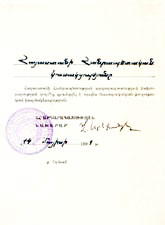 Being an ideological structure, the RPA has always focused on disseminating and enrooting its ideology and approach in the society. «The Republican» party's official newspaper, the «The Nationalist» book series, Tseghakron and Taronakan teachings, many analytical booklets highlighting Garegin Nzhdeh’s life and work, various commemorations and celebrations, pilgrimages, etc. served this target.
Being an ideological structure, the RPA has always focused on disseminating and enrooting its ideology and approach in the society. «The Republican» party's official newspaper, the «The Nationalist» book series, Tseghakron and Taronakan teachings, many analytical booklets highlighting Garegin Nzhdeh’s life and work, various commemorations and celebrations, pilgrimages, etc. served this target.
In 2001, on the initiative of Prime Minister Andranik Margaryan, Garegin Nzhdeh’s 115th anniversary was celebrated at the state level. A number of educational and scientific institutions were involved in the celebrations, Nzhdeh’s works were published in two volumes, newly discovered works written by the great Armenian were brought to our country from Bulgaria.
The parliamentary elections of 25 May 2003 resulted in increasing the number of the Republican Party’s seats in the Parliament, compared to 1999 elections. Thus, in the Parliament of 3rd convocation the Republican Party had the biggest faction with 40 MPs.
In 2003, as a result of negotiations, the three political forces supporting RA President Robert Kocharyan- the Republican Party of Armenia, the Armenian Revolutionary Federation and the Rule of Law Party (Orinats Yerkir) formed a parliamentary coalition and confirmed it with a Memorandum signed by the leaders of the three parties.
Andranik Margaryan continued to head the Armenian Government, where seven ministers nominated by the RPA were in the office. The Parliament Deputy Speaker and three out of the six chairpersons of parliamentary standing committees were also elected from the Republican Party.
In May 2006 the Rule of Law Party left the parliamentary majority, and the National Assembly was subject to rearrangements of political forces, which resulted in RPA Chairman Tigran Torosyan becoming the Speaker of the Parliament.
The RPA 10th extraordinary congress of July 2006 proclaimed the Republican Party of Armenia a national conservative party. The congress decided to restore the office of the party council chairperson, which had been abolished in 2005. Serzh Sargsyan was elected a chairperson of RPA Council.
On 25 March 2007 passed away the RPA chairman Andranik Margaryan, and the council chairman Serzh Sargsyan assumed the duties of the RPA chairman. On 4 April Serzh Sargsyan was appointed RA Prime Minister.
At the parliamentary elections of 12 May 2007, 33.9% of voters supported the Republican Party of Armenia. RPA faction was formed with 64 MPs. RPA Vice Chairman Tigran Torosyan was elected Speaker of the Parliament. The Republican Party signed a coalition memorandum with the Prosperous Armenia Party, and a memorandum of cooperation with the Armenian Revolutionary Federation.
Government led by Serzh Sargsyan was formed based on the results of parliamentary elections.
On 10 November 2007 the 11th ordinary congress of the RPA was held, and some amendments to the Charter were made. The office of the party council chairperson was abolished, and the RPA Executive body was elected as the permanently functioning governing body, while the RPA Council was elected as the party's representative body. Serzh Sargsyan was elected RPA chairman.
At the presidential elections of February 2008 Serzh Sargsyan was elected President of the Republic of Armenia. The Republican Party of Armenia, the Prosperous Armenia Party, the Armenian Revolutionary Federation and the Rule of Law Party signed a coalition agreement, and based thereon was formed the Government led by Tigran Sargsyan.
Following Tigran Torosyan’s resignation in September 2008 Hovik Abrahamyan, member of the RPA executive body, was elected Speaker of the National Assembly.
At the 12th congress of the RPA held in November 2009 RA President Serzh Sargsyan was re-elected as party chairman.
The elections to the Yerevan City Council of Elders were held in May 2009, where the RPA gained the overwhelming majority of mandates and formed the largest faction in the Council of Elders. Immediately after, RPA nominated candidates for the Mayor and First Deputy Mayor positions. In 2009, following the Council of Elders resolution, Mr. Gagik Beglaryan, member of RPA Executive body, was elected Mayor. In 2010 a member of RPA faction in the Council of Elders Mr. Karen Karapetyan became elected as Mayor. Deputy Mayor and member of RPA Council Mr. Taron Margaryan was elected Mayor in 2011.
In November 2011 after the resignation of the NA President Mr. Hovik Abrahamyan, Mr. Samvel Nikoyan, member of RPA Council, was elected NA President.
At the 13th congress of the RPA held on 10th March of 2012 RA President Serzh Sargsyan was re-elected as party chairman.
RPA Faction of RA NA 5th convocation was established on 31 May 2012. The quantity of NA members in the Faction of RA is 69, from which 53 members represent RPA.
On May 31, 2012 RPA Vice President, Head of RPA Political Committee Hovik Abrahamyan was elected as the President of the National Assembly of the Republic of Armenia of the fifth convocation.
At the 14th extraordinary congress of the Republican Party of Armenia which took place on December 15, 2012, the RA current President Serzh Sargsyan was unanimously nominated as a presidential candidate.
Serzh Sargsyan was elected President of the Republic of Armenia in the Presidential elections of February 18, 2013. Republican Party of Armenia and “Rule of Law” Party signed a coalition agreement, and based thereon was formed the RA Government led by Tigran Sargsyan.
Republican Party of Armenia, receiving the overwhelming majority of the votes in Yerevan Council of Aldermen elections, formed the largest faction in the Council of Alderman and nominated mayor’s candidature. According to the results of the elections, member of the RPA Board Taron Margaryan was re-elected Mayor of Yerevan.
At the 15th congress of the RPA held on 24th May of 2014 RA President Serzh Sargsyan was re-elected as party chairman.
At the 16th congress of the RPA held on 26th November of 2016 RA President Serzh Sargsyan was re-elected as party chairman.
Over the past 25 years RPA carved its hard way in its inner political life, in the countries domestic political arena as well as in the process of establishing Armenian statehood. Following Artsakh liberation and having tackled the economic crisis, social conflicts, political and ideological oppositions, RPA remains committed to building new Armenia based on the main principles of democracy. Republican Party of Armenia has always focused on reinforcing the statehood, building a society based on the principals of pluralism and tolerance, peace, human dignity and freedom, equality and rule of law.
RPA has always had a clear vision of the country’s development course, being strategically oriented on building Armenia capable of uniting Armenians worldwide, preserving and promoting national values based on the best achievements and experience of world civilizations.
Being largely involved in public administration and local self-government bodies, RPA maintains its influence in the Armenian political arena, as a party with proven record and strong ideology.


